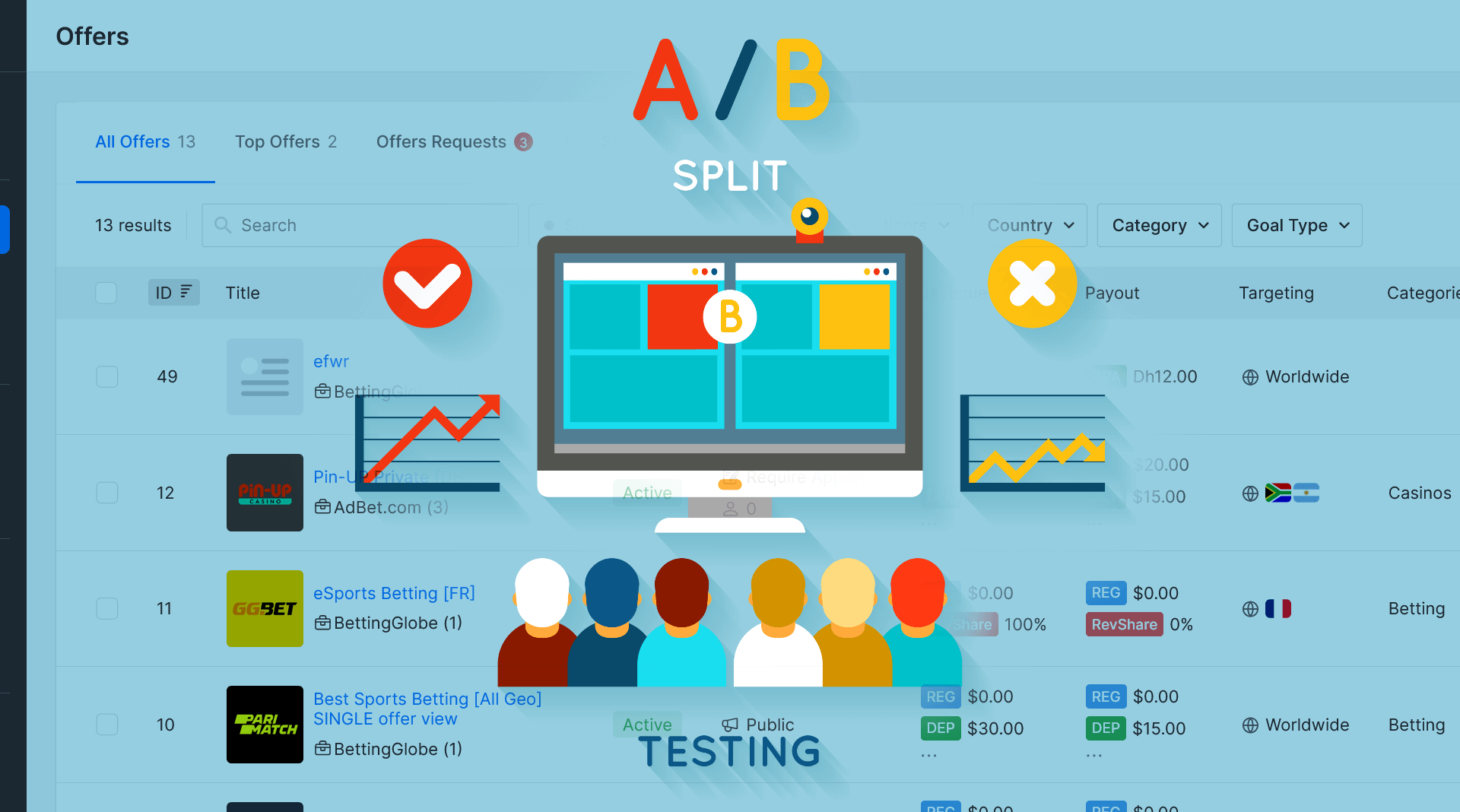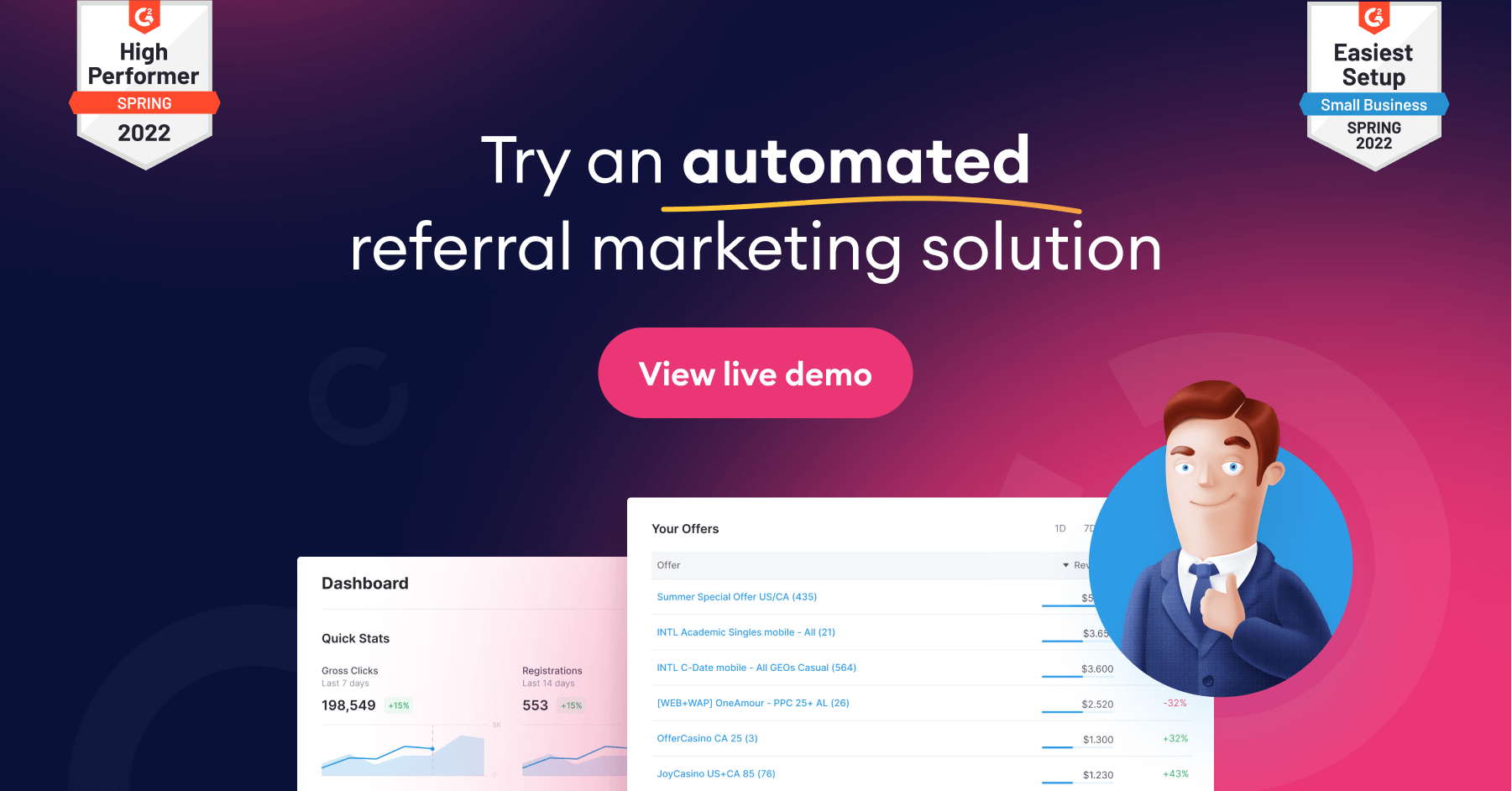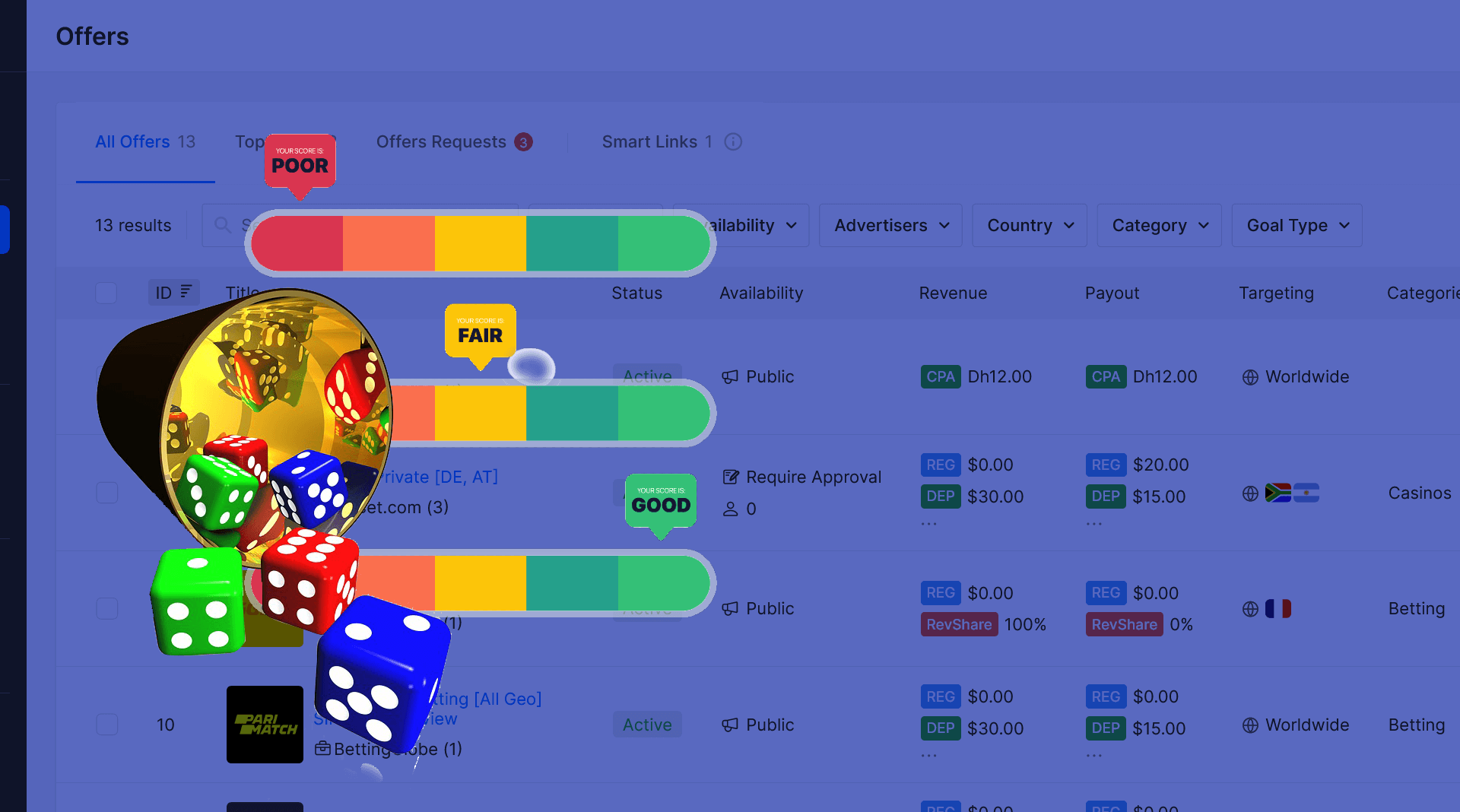A/B testing, also known as split testing, is a valuable marketing technique that allows businesses to test variations of their campaigns and determine which performs better.
This process is crucial in iGaming affiliate campaigns, where optimizing conversion rates can lead to significant revenue growth.
In this article, we will explore 10 ways to effectively conduct A/B testing in iGaming affiliate campaigns and show you how you can increase the revenue from your affiliate marketing channels thanks to simple campaigns split testing.
Understand the concept of A/B testing:
A/B testing is a marketing experiment wherein two variations of a campaign are tested against each other to determine the better performing version. It involves splitting your audience and showing version A to one group and version B to another.

Identify your goals
Before conducting A/B testing, defining clear goals for your iGaming affiliate campaign is essential. This will guide your testing process and help you measure the success of your experiments effectively. Whether you want to increase website traffic, improve conversion rates, reduce bounce rates, or optimize product images, clearly identifying your goals will enable you to focus your efforts and make informed decisions.
Choose what to test
In iGaming affiliate campaigns, there are several elements that can be tested, such as subject lines, CTAs, headers, titles, fonts and colors, product images, blog graphics, body copy, navigation, and opt-in forms. The possibilities are endless when it comes to optimizing your campaign for better performance. But with so many options, how do you choose what to test?
Well, it all comes down to your goals and priorities. Start by identifying the elements that are crucial to your campaign’s success. For example, if you’re looking to increase click-through rates, you might want to focus on testing different CTAs or subject lines. If improving user engagement is your goal, you could test variations in blog graphics or navigation.
Once you have a clear understanding of what you want to achieve, prioritize the elements that are most likely to have a significant impact on your campaign’s performance. It’s important to strike a balance between testing a wide range of elements and staying focused on the ones that matter the most.
Remember, A/B testing is an iterative process. You can always test new elements and refine your campaign as you gather more data and insights. So don’t be afraid to experiment and try out different variations. With each test, you’ll gain valuable knowledge about what works and what doesn’t, enabling you to make informed decisions for future optimizations.
Use a testing platform
To conduct A/B testing effectively, use a reliable testing platform like VWO or Google Optimize.
These platforms provide you with the necessary tools and features to create and run tests, collect data, and analyze results. With a testing platform, you can easily set up and manage A/B tests without the need for complex coding or technical expertise.
Using a testing platform offers several benefits:
- Streamlined testing process: The platform guides you through the steps of setting up and running A/B tests, making the process simple and efficient.
- Accurate data collection: Testing platforms provide accurate data collection, ensuring that the results you obtain are reliable and trustworthy.
- Real-time reporting: With a testing platform, you can access real-time reports on the performance of your A/B tests. This allows you to make data-driven decisions quickly and adapt your campaign accordingly.
When choosing a testing platform, consider factors such as ease of use, integration with your existing marketing tools, and customer support. Look for platforms that offer advanced targeting options, multiple testing variations, and robust data analysis capabilities.
Create 2 variations
To run an A/B test, create two versions of your campaign with changes to only one element. This could be anything from the color of a CTA button to the placement of an opt-in form. The key is to isolate the variable you want to test and ensure that only one thing is different between the two versions.
For example, if you’re testing different CTAs, Version A could have a bold, attention-grabbing button with vibrant colors, while Version B could have a more subtle, minimalist button with muted colors. By presenting these variations to different segments of your audience, you can compare their performance and determine which CTA resonates better.
A/B testing helps you gather valuable insights into your audience’s preferences and behaviors, allowing you to make data-driven decisions to optimize your iGaming affiliate campaigns.
When creating your variations, consider the specific goals of your campaign:
Are you trying to increase click-through rates? Improve conversion rates? Reduce bounce rates? By focusing on one element, you can pinpoint its impact on your desired outcome.
Keep track of the changes you make in each version so you can accurately measure and analyze the results.
Once you have created your variations, split your audience and show each group one of the versions. A reliable testing platform like VWO or Google Optimize can help you divide your audience and ensure each segment receives the appropriate variation.
By comparing the performance of the two versions, you can determine which one drives the desired results. Whether it’s increased click-through rates or higher conversion rates, the data collected during testing will provide valuable insights for optimization.
Continuously track the performance of implemented changes to ensure ongoing optimization. Regularly revisit your testing strategy and explore new variations to stay ahead of the competition and consistently improve your iGaming affiliate campaigns.
A/B testing is an ongoing process that should be integrated into your iGaming affiliate campaigns. By continuously testing, analyzing results, and implementing successful variations, you can optimize your campaigns, drive better results, and maximize revenue in this highly competitive industry.
Determine testing duration
When determining the ideal duration for your A/B test, it is crucial to consider the amount of time necessary to gather a substantial amount of data and reach reliable conclusions. The length of the testing period can differ based on your specific objectives and the intricacy of the experiment at hand.
However, it is generally advised to allocate a minimum of one week to ensure meaningful results. By allowing ample time for data accumulation, you enhance the accuracy and validity of the conclusions drawn from your A/B test.
Monitor and collect data
During testing, closely monitor the performance of each version and collect data on metrics like click-through rates, conversion rates, bounce rates, and engagement. These metrics will help you gauge effectiveness and determine which version performs better.
Use analytics tools like Scaleo or Google Analytics to track and analyze the data, allowing you to draw meaningful conclusions about performance.
Analyze results & improve
After the testing period, analyze the collected data to determine which variation performed better. Look for statistically significant differences in the metrics you measured. By comparing the results, you can draw conclusions about the effectiveness of each variation.
Metrics like click-through rates, conversion rates, bounce rates, and engagement levels aren’t just numbers; they are actionable insights that guide your next move. Analyzing this data effectively is crucial for discerning which version of your campaign outperforms the other.
For those seeking a comprehensive yet straightforward solution for tracking and analyzing these essential metrics, Scaleo offers an all-in-one platform designed with affiliate marketers in mind.

With its robust analytics and real-time data collection features, Scaleo allows you to make well-informed decisions that lead to optimized campaign performance. Ultimately, quality data leads to quality decisions; make sure you’re equipped with the right tools to gather it.
Conclusion
A/B testing is a non-negotiable component of any robust iGaming affiliate campaign. Implementing these 10 strategies can help you optimize conversion rates, drive better user engagement, and ultimately, increase ROI.
While various tools can assist you in this analytical endeavor, Scaleo offers a seamless, comprehensive solution tailored for affiliate marketers. Your campaign’s success is rooted in data, and Scaleo ensures that your decisions are both informed and impactful. The choice is yours: continue guessing or start optimizing.

Last Updated on March 19, 2024





